
Asus Vivobook Pro 16X OLED M7600Q review – Hitting the Power and Price Sweet Spot for Content Creators
Asus has released a veritable slew of content creator laptops, all of which come with luscious OLED displays and various combinations of CPUs and GPUs but the new Asus Vivobook Pro 16X OLED M7600Q aims to hit the sweet spot for price and performance.
Combining AMD Ryzen 5000 series CPUs with NVIDIA RTX 30XX series graphics along with a 16-inch 4K OLED display, the Asus Vivobook Pro 16X OLED M7600Q is a respectable rig that looks capable of tackling most casual content creator tasks. Here’s our Asus Vivobook Pro 16X OLED M7600Q review where we put it to the test to see if it’s worth the money.
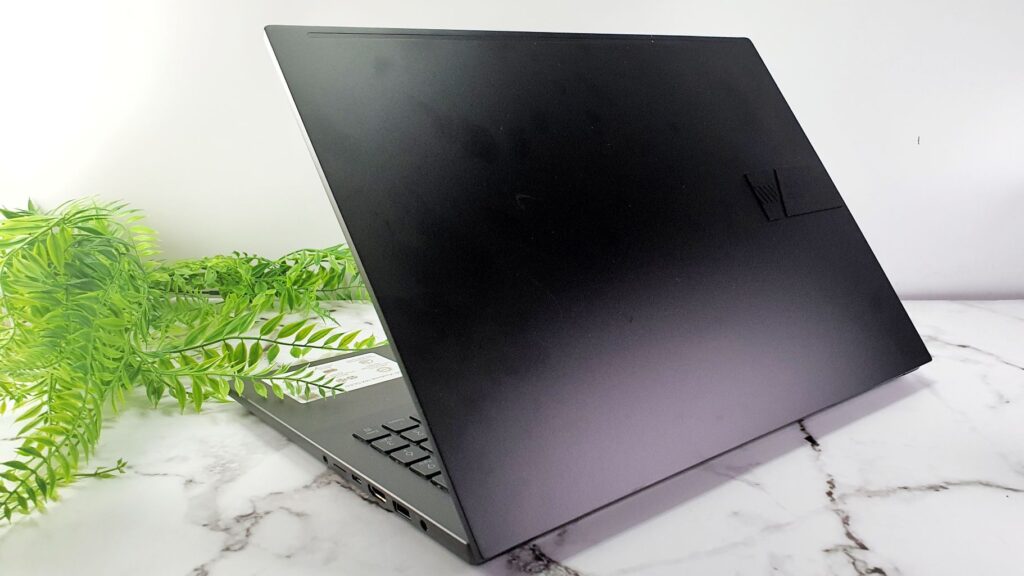
Asus Vivobook Pro 16X OLED M7600Q Review – Design
Table of Contents
In terms of design, our Asus Vivobook Pro 16X OLED M7600Q review sample resembles the Vivobook Pro 15 OLED M3500Q that we reviewed earlier a couple of weeks back scaled up to larger dimensions to accommodate the larger 16-inch 4K OLED display and larger DialPad touchpad. It also has relatively similar specifications save for the aforementioned larger display, a slightly better RTX 3050 Ti GPU and a larger 96Wh battery.
By that same token, the Asus Vivobook Pro 16X OLED M7600Q has the same strengths and, alas, the same design flaws befalling its smaller sibling the Vivobook Pro 15 OLED M3500Q.
In terms of materials, you get an aluminium top lid and keyboard tray with a polycarbonate underside. The top lid of the Asus Vivobook Pro 16X OLED M7600Q has a matte black finish with an embossed Vivobook logo in the corner. It looks suitably stylish, repels fingerprints nicely but is also on the thin side and has a minor bit of flex.

Determined prodding will show a bit of give in the center portion of the lid though it’s marginally sturdier than the Vivobook Pro 15 OLED. The laptop lacks any official MIL-STD-810 durability rating so some care needs to be taken to avoid the usual hazards like drops, water and extremes of temperature.
Much like its smaller sibling, the Asus Vivobook Pro 16X OLED M7600Q eschews their Ergolift Hinge design for a more conventional hinge and relies on a set of rubber feet on the underside to prop it up for a modicum of air circulation.
The underside is made entirely of polycarbonate but is built in a sturdier fashion than the Vivobook Pro 15 OLED and noticeably has no give in the lid. Bar the grilles for ventilation, the underside also features another pair of grilles for the downward firing speakers that are placed below roughly where the palm rests are.
Gaining access to the hardware is a bit of a chore though as the underside of the laptop is held in place by torx screws though the point is somewhat moot in any case as there are few upgradable components in the laptop itself.
In the case of the display, our Asus Vivobook Pro 16X OLED M7600Q review sample comes with a much larger and taller 16-inch 4K OLED display that has a 16:10 aspect ratio, has 100% DCI-P3 and has also been Pantone validated with VESA DisplayHDR True Black 500 certification.
This means that the display is capable of offering superbly accurate colour reproduction which is critical for content creators like photographers and video editors. The only niggle is that the refresh rate is capped at 60Hz but seeing as this isn’t intended as a gaming laptop, it’s not a critical factor. The laptop also features a webcam up top with a privacy slider.
Of note here are the solid hinges that keep the display fixed in position at whatever angle you set it at though they are on the stiff side which means that opening the laptop is a two-handed affair.

The keyboard on offer is a full sized model complete with a numeric keypad, a hazard stripe running across the Enter key and a neon orange highlight on the Esc key.
Bar the provided power brick and charger, there’s little else bundled with the laptop in terms of accessories though it does ship with a free copy of Microsoft Office Home & Student 2019.
Overall build quality is good and the practical finish and relatively sturdy finish make it relatively man portable though the 1.95kg carry weight means that it’s not something you want to tote around all day.
Asus Vivobook Pro 16X OLED M7600Q Review – Ports
Ports and I/O configuration are identical to the smaller Vivobook Pro 15 OLED M3500Q and has the same shortcomings, namely that the majority of essential ports are all clumped up on the right side of the laptop which means that it interferes with ergonomics, especially if you rely on a traditional mouse.
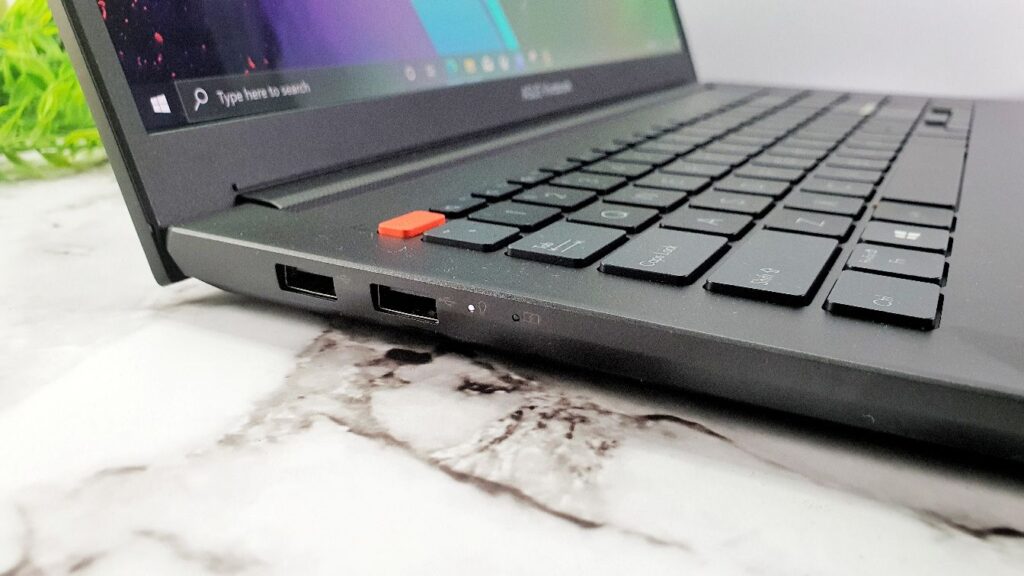
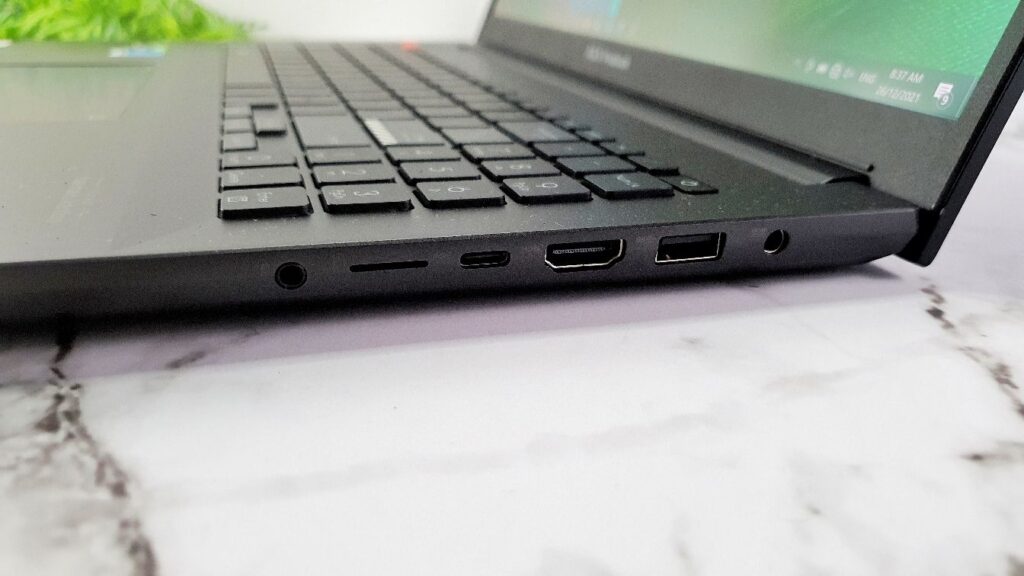
The left side hosts two USB 2.0 ports for hooking up peripherals while the right side hosts a barrel-style DC-IN plug for charging the laptop, a USB-A 3.2 Gen1 port, a HDMI 1.4b port, a USB-C 3.2 Gen 1 port, a microSD card reader and a 3.5mm combo jack. This ensemble of ports covers most eventualities and the HDMI port allows you to output to a larger 1080p display.
What is the Asus DialPad?
Fortunately, the larger dimensions of the Asus Vivobook Pro 16X OLED M7600Q mean that they’re able to cram in a larger 16-inch display and a specialised DialPad touchpad.

The DialPad touchpad itself mimics the functionality of the more premium physical Asus Dial seen in the Asus ProArt StudioBook 16 OLED H5600QR that we reviewed a while back but reproduces the functionality via software on a touchpad. Unlike most normal touchpads, the Asus DialPad here is taller and wider than usual, with commensurately more generously sized palm rests.
Asus Vivobook Pro 16X OLED M7600Q Review – Specifications
In Malaysia, our Asus Vivobook Pro 16X OLED M7600Q review sample came with the following specifications:
| Price | RM6,499 |
| Display | 16-inch WQXGA OLED, 3,840 x 2,400 pixels, 400 nits, 16:10 aspect ratio, 550 nits, 100% DCI-P3, 100% sRGB, Vesa Certified HDR True Black 500, Pantone validated |
| Processor | AMD Ryzen 9 5900HX 3.3GHz, 4.6GHz Max Boost |
| OS | Windows 10 Home |
| Graphics | NVIDIA GeForce RTX 3050 Ti w/ 4GB GDDR6 VRAM 35W TDP (50W with Dynamic Boost) |
| Memory | 16GB DDR4 RAM/ 512GB SSD |
| Battery | 96Wh, 6 cell li-ion, 120W AC adaptor |
| Size/Weight | 360.5 x 259 x 18.9mm / 1.95kg |
Functionally speaking, it has a performance envelope that bears resemblance to the Vivobook Pro 15 OLED laptop as it uses the same AMD Ryzen 9 5900HX processor, 16GB DDR4 RAM and a 512GB M.2 NVME PCIe 3.0 SSD. 32GB RAM variants do exist but that variant is not slated for deployment to the Malaysia market.
Where the Asus Vivobook Pro 16X OLED M7600Q takes things up a notch is that it features a larger 16-inch OLED display with 3,840 x 2,400 pixels resolution with a slew of certifications for colour accuracy, a larger DialPad with enhanced functionality over a standard touchpad and an improved NVIDIA GeForce RTX 3050 Ti graphics card with 4GB GDDR6 VRAM.
The smaller Vivobook Pro 15 OLED uses a slightly lower-specced GeForce RTX 3050 which also has 4GB GDDR6 VRAM. While both GPUs are built on an 8nm process and run on NVIDIA’s newest GA107 Ampere GPU, they’re both slightly different with the 3050 Ti edging out slightly in terms of performance on paper.
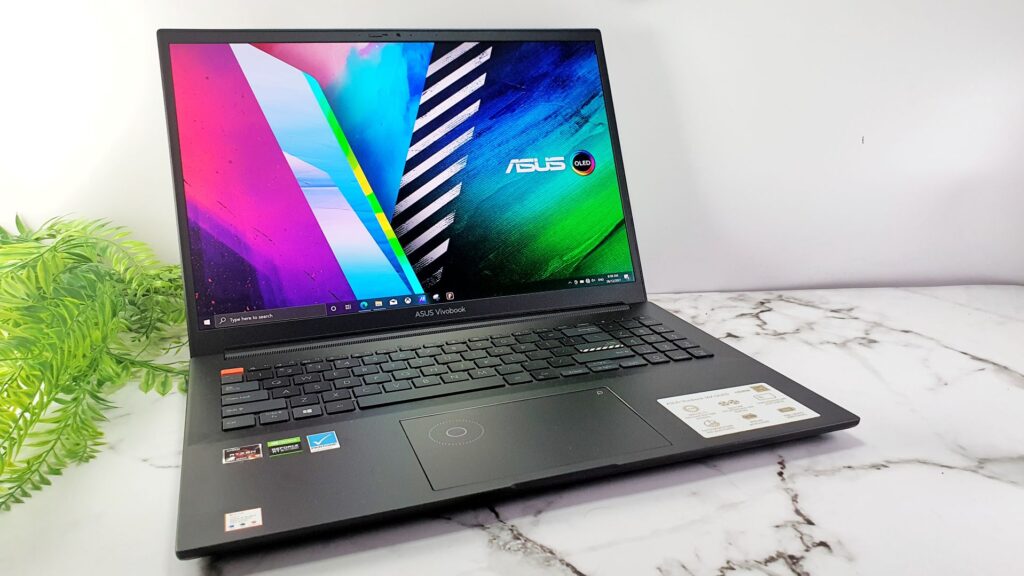
The NVIDIA RTX 3050 Ti has 2,560 CUDA cores clocked at 1,485MHz with a rated floating point performance of 5.3 TFOPs and up to a theoretical 80W of power though Asus has opted to keep the power draw modest here at 35W with a cap of 50W if you kick in full performance mode.
The RTX 3050 seen in the smaller Vivobook Pro 15 OLED is paced a bit behind with 2,048 CUDA cores running at 1,500MHz and a rated floating point performance of 4.3 TFLOPS and also has a similar 35W-50W TDP.
Boiled down, the NVIDIA RTX 3050 Ti is an improved, slightly faster version of the RTX 3050 though both the 3050 Ti and 3050 are still mobile graphic cards and aren’t powerful enough to fully exploit real time ray tracing in games.
Some other limitations for the laptop include the fact that the RAM is soldered in which means that the existing 16GB RAM is all you get. There’s also only one SSD bay so adding additional storage will be a chore as you’ll need to transfer your OS over to a larger SSD and then swap the existing one out.
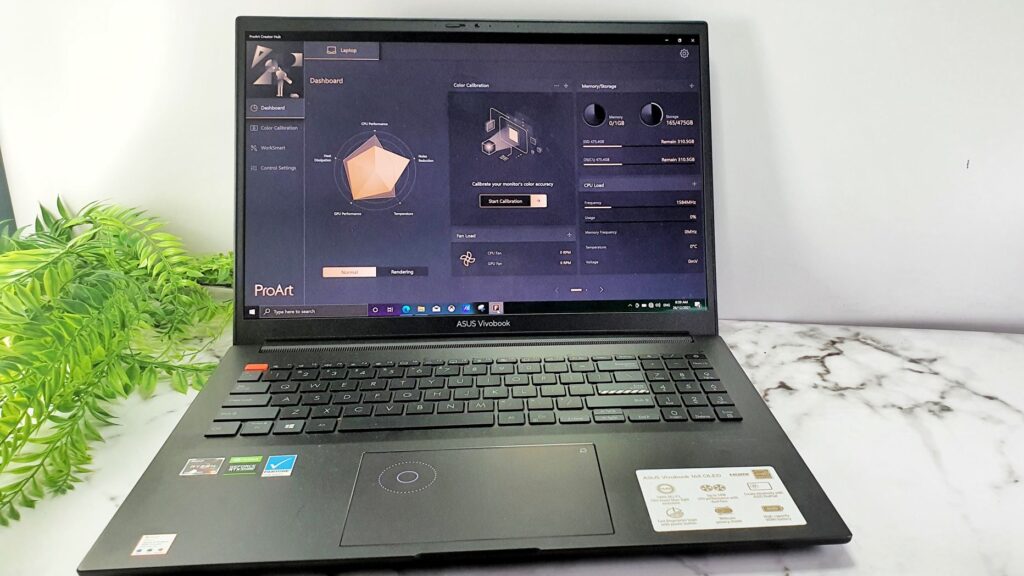
Hardware aside, the Asus Vivobook Pro 16X OLED M7600Q runs on Windows 10 Home out of the box with the option to upgrade to Windows 11 later and comes with their custom MyASUS firmware to manage fan speeds and power settings in one handy interface as well as the Asus ProArt Creator Hub that lets you calibrate the display colours and assign additional control modes to the DialPad. Much like the actual Asus Dial, the DialPad is primarily optimised to work with the Adobe suite of software and control some basic system settings like screen brightness and volume.
Asus Vivobook Pro 16X OLED M7600Q Review – Performance and Benchmarks
When put to the test in synthetic benchmarks, our Asus Vivobook Pro 16X OLED M7600Q review sample managed to eke out the following test scores when plugged in, with the laptop and fan speed set to maximum Performance.
Unfortunately, setting the internal IceCool Plus cooling fan settings to full performance mode also kicks up a noticeable racket that’s audible in a quiet library though it’s not that apparent if you’re using it in noisier places like a coffee shop.
| 3D Mark TimeSpy | 5,202 |
| 3D Mark TimeSpy Extreme | 2,433 |
| 3D Mark Fire Strike Ultra | 3,007 |
| 3D Mark Fire Strike Extreme | 5,725 |
| 3D Mark Fire Strike | 10,060 |
| Geekbench 5 Single Core | 1,418 |
| Geekbench 5 Multi Core Score | 7,087 |
| Geekbench 5 OpenCL Score | 58,341 |
| Cinebench R23 CPU Single core score | 11,939 |
| Cinebench R23 CPU Multi core score | 1,479, 8.07x MP ratio |
| PCMark 10 Extended | 6,809 |
| PCMark 8 Battery Life (Creative profile) | 5 hours 8 minutes |
| Far Cry 5 (High settings, 1,900 x 1200) | 77 average fps |
When compared side by side using similar testing parameters as its more affordable sibling the Vivobook Pro 15 OLED, the Vivobook Pro 16X OLED M7600Q has a comfortable performance lead across almost all benchmarks even though both laptops have the same AMD Ryzen 9 5900HX processor and similar amount of RAM, with much of the performance gains on account of the better NVIDIA RTX 3050 Ti GPU.
While it’s a bit better across the board, the Vivobook Pro 16X OLED M7600Q’s hardware is still not going to let you comfortably render 4K video as the soldered in 16GB DDR4 RAM and 4GB DDR6 VRAM on the GPU remain as system bottlenecks though it’s sufficient to comfortably edit 1080P video and, when you’ve clocked out for the day, run Far Cry 5 on High settings and reasonably run Cyberpunk 2077 and Halo Infinite at Full HD and high settings without it ending up like a slideshow.
The provided downward firing stereo speakers are fairly well appointed with reasonable volume and detail though the provided bass isn’t particularly stellar. It’ll do the job for a Netflix session but more discerning users will likely require a more precise audio setup for video editing work.
In terms of practical battery life, we tested it with the fans set to full performance mode and the power settings on maximum using the Creative benchmark in PCMark 8 which tests a hefty content creator workload. The laptop’s 96Wh battery managed to last a very respectable 5 hours and 8 minutes and this is the laptop going at it full tilt with a full-fledged workload which is impressive indeed.
Vivobook Pro 16X OLED M7600Q Review – Display Performance
The main draw with the Vivobook Pro 16X OLED M7600Q is its luscious, colour accurate 16-inch 4K resolution display and a tall 16:10 aspect ratio with a rated 100% DCI-P3, Pantone validation, VESA DisplayHDR True Black 500 and a 60Hz refresh rate along with 550 nits peak brightness though the official literature for the laptop doesn’t list if it has been Calman verified or has TUV Rheinland certification for eye protection which means it has less rigorous certification versus the panel seen in the more premium Asus ProArt StudioBook 16 OLED that we reviewed awhile back.

Screen brightness is rated at 550 nits and it’s easily visible under daylight conditions though the glossy finish means it’s harder to view under overhead neon lighting.
Make no mistake though, what Asus has is plenty sharp, vibrant and crisp which makes it ideal for its intended mission profile for content creation and should be sufficient for colour grading and photo editing work.
Asus DialPad performance
The provided DialPad is a compromise of attempting to provide the functionality of the Asus Dial in a touchpad. Turning it on requires you to firmly press the upper right corner of the touchpad and slide it down which often requires several repeats for it to happen.
When activated, a portion of the touchpad turns on that shows you where to tap. For its purposes, it’s effective and responsive but the lack of tactility due to the lack of a physical dial means you’ll have to constantly keep looking down to see if you’re poking about in the right place.
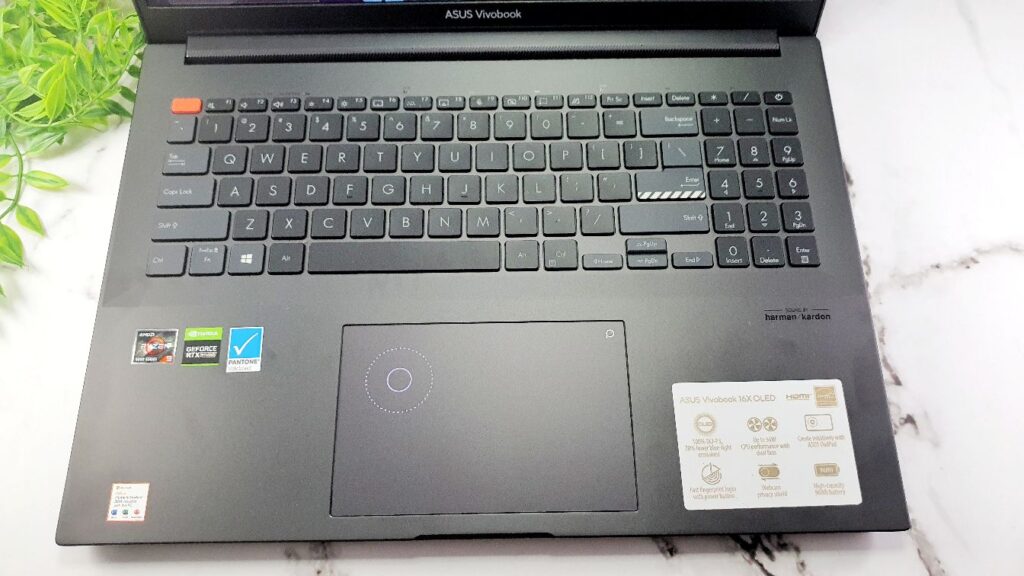
In terms of functionality, the Asus Dial is able to control some basic Windows settings like volume and brightness or to jog between apps and virtual desktops. At present, it has native support for the Adobe suite of apps including After Effects, Lightroom Classic, Photoshop and Premiere Pro but native support for DaVinci Resolve isn’t available at the time of writing which reduces its appeal somewhat for those who haven’t hopped onto the Adobe bandwagon
Should you buy the Vivobook Pro 16X OLED M7600Q
The Asus Vivobook Pro 16X OLED M7600Q is an interesting median point between the pricey but powerful ProArt StudioBook 16 OLED and the modest Vivobook Pro 15 OLED with a luscious 4K OLED display, a solid CPU and a decent GPU but the soldered in RAM and quaint clustered ports on its right side may give more serious content creators pause.

If you’re looking for a 4K OLED content creator laptop with credible battery life and a fairly decent set of hardware for casual gaming and modest content creation, the Vivobook Pro 16X OLED M7600Q makes for a worthy choice.
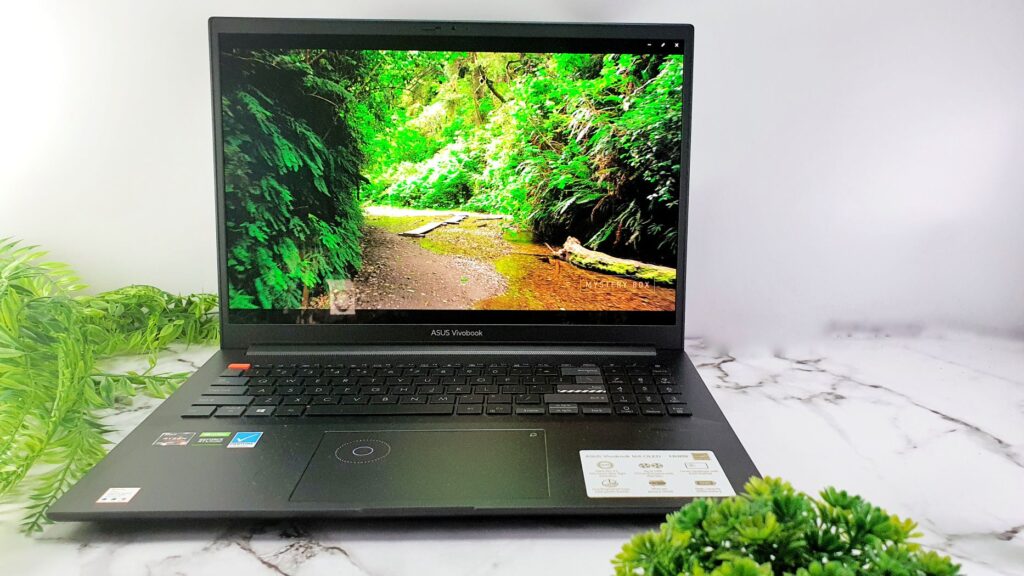
Asus Vivobook Pro 16X OLED M7600Q review unit courtesy of Asus Malaysia. For more details please visit:
ASUS Vivobook Pro 16X OLED M7600Q
-
Display
-
Performance
-
Battery Life
-
Design
-
Value
ASUS Vivobook Pro 16X OLED M7600Q
The ASUS Vivobook Pro 16X OLED M7600Q is a sound choice for casual content creators and gamers with its superb 4K OLED display and decent specifications, though more serious content creators should explore the higher end options in their Asus ProArt line-up.
Pros
Beautiful and colour accurate 4K OLED display
Good performance to price ratio for content creation
Novel DialPad
Good battery life
Cons
Most essential ports on right side of laptop
Fans get loud in full performance mode
RAM soldered in
Only one M.2 NVME PCIe 3.0 SSD bay
Low 60Hz OLED refresh rate display not intended for gamers
DialPad only works with Adobe suite for now
